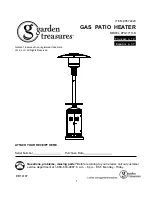
36
ONLY USE GENUINE HAYWARD REPLACEMENT PARTS
51300803801 REV B
MAINTENANCE AND SERVICE
PERIODIC INSPECTION:
The heater is designed and built for long performance life when installed and operated according to the manufactur-
er’s directions. Regular inspection by qualified service personnel is recommended to keep the heater working properly. The following inspec-
tion points are suggested to help maximize heater life.
1. Periodically check the venting on outdoor heaters. The heater’s venting areas (the louvered top panel) must never be obstructed in any
way and minimum clearances must be observed to prevent restriction of combustion and ventilation air. Remember that shrubs grow and
in time may obstruct a heater’s venting areas.
2. Check the venting of indoor heaters for looseness and possible leaks. Keep all openings for combustion and ventilation air clear and unob-
structed.
3. Keep the entire pool heater area clean and free of all debris, combustible materials, gasoline, and other flammable vapors and liquids.
Remove any leaves or paper from around the heater.
4. Do not store chlorine, other pool chemicals, or other corrosives in the vicinity of the heater.
5. If the heater is operating on propane gas, the tank must not fall below 30% full or damage to the heater may occur. Manufacturer will not
be responsible for heaters that soot up due to improper gas level in the tank resulting in inadequate gas volume.
6. If another appliance is added to the gas line at a later date, consult the local gas company to be sure the gas line will have the capacity to
supply both units at full input rating at the same time.
7. Do not use the heater if any part has been under water. Contact a qualified service technician to inspect the entire heater and replace any
part of the control system or gas valve that was under water. If heater has been totally submerged in water it must be removed and the
entire heater must be replaced.
8. An inspection program is a good preventative maintenance measure. Keep this manual in a safe place for future reference for yourself as
well as for a service technician to consult when inspecting or servicing the heater. Any additional inspection procedures are to be per-
formed by a qualified service technician.
WATER CHEMISTRY:
The heat exchanger in your pool heater is made from the highest quality of copper and nickel (Cupronickel) materials. This premium material
and the exacting processes used to manufacture the heat exchanger is state of the art in pool heater design and manufacture. However, it
remains vital that the heat exchanger be protected from damaging or corrosive chemicals, insufficient water flow or improperly balanced water
chemistry. Heat exchanger damage or failure resulting from improper flow, improperly balanced pool water or the improper addition of sanitizer
into the water is NOT covered under the terms of the warranty. The following factors are critical to heat exchanger protection. Follow the guide-
lines in Table 15 to help prevent pre-mature damage to or failure of your heater and heat exchanger.
1.
WATER FLOW THROUGH HEATER
: Water must be flowing through the heater at the minimum rated flow rate during operation. Check
that the pump is operating and the system is filled with water and purged of all air prior to starting the heater. The minimum flow rates are
listed in the specifications section. Some installations may require an adjustment to the water pressure switch for proper low-flow protec-
tion. Test your system and if necessary, adjust the water pressure switch as described in the
WATER PRESSURE SWITCH ADJUST-
MENT PROCEDURE
in this manual.
2.
WATER CHEMISTRY
: The chemistry balance and mineral content of swimming pool and spa water changes rapidly due to many factors
including, but not limited to, the addition of sanitizing chemicals, user loads, exposed rain, runoff, and the amount of sun. Improper chem-
istry (see Table 15) balance and mineral content can cause scaling and deposits to form on pool walls, in the filtration system, in the heat
exchanger tubes, and additionally can promote corrosive action to all metals in the water path. Changing spa water regularly and maintain-
ing the correct chemical balance in your pool/spa will keep the pool/spa safe and sanitary and will help heat exchanger longevity. Use a 4-
way pool/spa water test kit to check your water frequently (at least weekly). Use the guidelines in Table 15 to help maintain proper water
chemistry:
WARNING:
WATER CHEMISTRY
Failure to maintain proper water chemistry may cause premature heat exchanger damage or failure









































